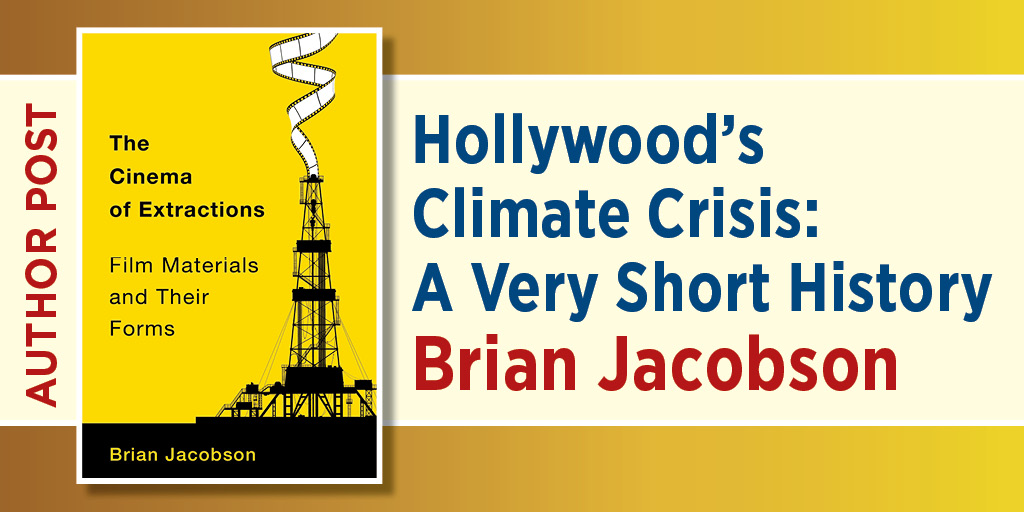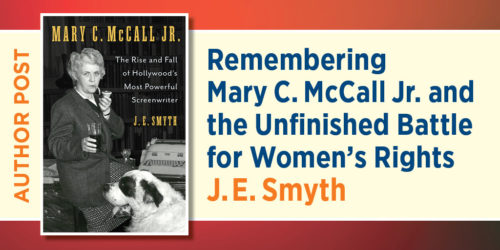Hollywood’s Climate Crisis
A Very Short History
Brian Jacobson

On January 8, 2025, AI-generated images of the famous Hollywood sign engulfed in flames began circulating on social media. A wildfire in the Hollywood Hills had triggered evacuation warnings as far south as Sunset Boulevard and east to the old Warner Bros. lot, but the famous sign was never directly threatened. Still, the image captured something of the reality of the Los Angeles wildfires, which upended life in every corner of the city and added to the growing list of woes facing its iconic industry. Asked about the fire’s effects on workers already suffering from pandemic-era cuts and post-2023 strike slowdowns, the director Adam McKay pinned Hollywood’s connected economic and ecological crises on its business model:
Well, it’s all interconnected, right? What you’re seeing . . . is the hyper-financialization and corporatization of studios and streamers where everything now is just immediately funneled into the boardroom. That’s been brutal. That economic model is what’s antagonized the climate crisis. When you look at things only through quarterly revenue models and your only responsibility is to shareholders, that’s a destructive machine.
Missing from McKay’s formula is the industry’s much older ties not simply to finance capital but more specifically to the extractive industries that have driven climate change and powered cinema from its origins. The long historical arc of Hollywood’s “destructive machine” must return us, in other words, to the time long before the industry’s twenty-first-century financialization, back when American cinema took form both powered by and in the image of the big American technology and energy companies of the nineteenth century.
American cinema’s relationship to the climate crisis that threatens Hollywood infrastructure with nearly annual bouts of dangerous wildfire is both deeply material and as old as film itself.
In the United States, film emerged in the 1890s from one of the nation’s big tech centers: the Edison laboratory in West Orange, NJ. Developed in tandem with technologies including ore-drilling equipment, batteries, electric lights, and, most importantly for Edison, electricity, cinema was defined by a milieu of interconnected technological innovation. Though the development of the vast commercial film industry in the 1910s eventually made “the movies” seem distinct from the scientific and technological context of their origins, film was never, in practice, separated from those roots.
As Edison camera operators left the lab, they quickly trained their new lenses on the stuff of modern industry and the technological infrastructure that Edison was helping create. Cars, trains, ships, subways, mines, bridges, skyscrapers, and sparkling electric lights became the stuff of early film. Partnerships with rail companies helped send cameras and their operators across the country, and in turn Edison filmmakers ensured that glamorized images of steaming locomotives—and dramatic urban landscapes shot from moving trains—filled American screens.
Edison was not alone in recognizing film’s power to shape the modern visual imaginary with glamorized images of industrial development. One of his primary adversaries in the electricity business, George Westinghouse, partnered with Edison’s chief film competitor, the American Mutoscope and Biograph Company. Westinghouse helped outfit Biograph’s new studio with electric lights, and Biograph filmmakers in turn made a series of important films about the Westinghouse factories for the 1904 St. Louis World’s Fair.
It’s also that film, at its core, has always been about the ambition to control nature, a control that rests, however, on an unsustainable dependence on resource extraction and large-scale energy consumption.
As film became an entrenched part of commercial entertainment in the early 1900s, its material requirements intensified. Companies such as Eastman Kodak, the nation’s primary source of film stock, developed local resources and supply chains to maintain stocks of raw materials that included thousands of gallons of water pumped daily from Lake Ontario, gelatin pulled from herds of cattle, cellulose harvested from fields of cotton, and silver extracted from mines in Canada, the United States, and Bolivia. Once it reached film companies increasingly focused on producing long-form narrative fiction, Kodak’s film was more and more often exposed using electric lights, even as filmmakers fled the short gloomy days of East Coast and Midwest winters for sunny Southern California.
The industrialization of Hollywood in the mid-1910s further intensified film’s resource dependency. Companies such as Paramount bought forests in Oregon to source wood for building stages and sets. Oil and gas flowing from Los Angeles’s vast petroleum fields offered fuel for studio lights and the vast fleets of automobiles that California film companies needed to move cast and crew around their growing backlots. The fields also became locations for early shorts and eventually feature films such as Lois Weber’s 1915 oilfield drama, Sunshine Molly, and they caused a reported “oil craze” among film stars such as Buster Keaton, who were attracted by the promise of quick gushing wealth.
Some companies suspected that their studios sat above valuable petroleum reserves, and in the 1950s they began seeking new sources of profit by drilling on their own lots. 20th Century Fox, for example, had made more than $3 million in profit from its oil venture by the early 1960s, and some industry observers argued the companies would be better off shifting entirely from film to oil.
In a deeply material way, Hollywood had been making these scenes for years, and the fires burning film town were all too real.
With the arrival of companies such as Gulf+Western and a first phase of Hollywood conglomeration in the 1960s, film and oil found other ways to share space on the balance sheet. And from there we might skip ahead to 2025 and Adam McKay’s argument about financialization’s detrimental effects on both Hollywood and the global climate. As this short account of cinema’s entangled history with oil should suggest, however, American cinema’s relationship to the climate crisis that threatens Hollywood infrastructure with nearly annual bouts of dangerous wildfire is both deeply material and as old as film itself. It isn’t just that financialization and conglomeration have created the “economic model” behind the climate crisis. It’s also that film, at its core, has always been about the ambition to control nature, a control that rests, however, on an unsustainable dependence on resource extraction and large-scale energy consumption.
In recent years, Hollywood has taken steps to change this story. In 2021, the Producer’s Guild of America called for a 50 percent reduction in emissions by 2030. And groups such as the Sustainable Entertainment Alliance and the Environmental Media Association are pushing for changes in both the industry’s material practices and in how it tells stories about the environment. For his part, McKay founded Yellow Dot Studios to produce content designed to spark climate awareness and counter corporate disinformation.
On January 9, 2025, as firefighters rushed to contain the blaze threatening Sunset Boulevard, Yellow Dot released the latest of its “Extreme Weather Reports,” a series of newsreel style compilations featuring video of fires, floods, and other disasters from around the world. This time it was Los Angeles itself, and there was no need for AI to generate these unreal images. In a deeply material way, Hollywood had been making these scenes for years, and the fires burning film town were all too real.
Brian Jacobson is professor of visual culture at the California Institute of Technology and the author of The Cinema of Extractions: Film Materials and Their Forms.
Categories:Author-Editor Post/Op-EdEarth DayEnvironmental StudiesFilmMedia StudiesPolitics
Tags:Climate ChangeClimate of ContemptDavid B. SpenceEarth MonthEarth Month 2025Environmental AwarenessExtractive IndustriesFilm IndustryFinancializationHollywoodResource DependencySustainable PracticesTechnological InnovationU.S. Energy TransitionVoter Partisanship





